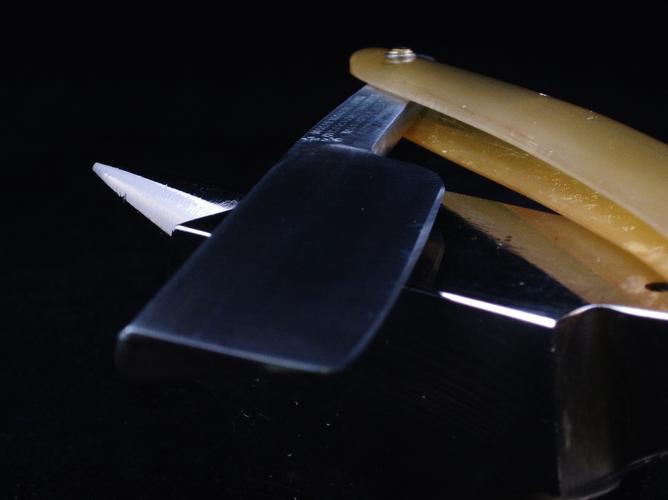Results 1 to 10 of 80
Thread: Douglas cutlery
Hybrid View
-
06-23-2013, 03:19 AM #1Historically Inquisitive



- Join Date
- Aug 2011
- Location
- Upstate New York
- Posts
- 5,781
- Blog Entries
- 1
Thanked: 4249
1. No one really knew what a razors edge looked like or how they dulled before 1933.
The fact is in 1879 they were looking at razors edge with a microscope http://straightrazorpalace.com/honin...-use-hone.html Read the article! 54 years before your magazine came out!
-
The Following User Says Thank You to Martin103 For This Useful Post:
Hirlau (06-23-2013)
-
06-23-2013, 07:31 AM #2

"Of course many attempts have been made to photograph razor blades. Most of these pictures have, however, been taken with a magnification of only a few hundred diameters and the true cutting edge has escaped the camera"
Now I suppose we're going to discuss the difference between evidence and better evidence. That way we can continue to evade the point ad-nauseam. I did not write the above article in 1931, I was ask on what I based my conclusions, here's part 1. If you think this article is incorrect I would suggest you take that up with Popular Science.Last edited by bishpick1; 06-23-2013 at 08:37 AM.
-
06-23-2013, 09:13 AM #3

https://www.google.fr/search?q=razor+blade+sem
Interesting photos in the picture search. Tired of the Überlather ? Try the Unterlather !
Tired of the Überlather ? Try the Unterlather !
-
The Following User Says Thank You to dudness For This Useful Post:
bishpick1 (06-23-2013)
-
06-23-2013, 08:58 AM #4
-
06-23-2013, 10:40 AM #5

Actually I did read the 1879 article. The 1931 article said the 1879 article was wrong and its conclusions no better than myth. It actually refers to the conclusions of the 1879 article.
"Pratt’s investigation proves definitely that the “saw tooth edge” is a myth, an optical illusion."
In fact the 1879 article was saying the assumptions by the razor makers about their edges were false and not based in science (sound familiar?).
The 1931 article said the razor makers were right to start with, and that science had been wrong for 54 years.
Of course neither article directly mentions the razor makers assumptions, but I feel safe making these jumps in logic. Besides it helps me make my point.
Last edited by bishpick1; 06-23-2013 at 10:52 AM.
-
06-23-2013, 12:44 PM #6

I'm one of the few members who was around in 1879 and has flown a SR-71 Blackbird. Sharp blade make whisker go away. This thread almost made me want to go to church....but....nah, I'll keep my 48 year record intact.
"Call me Ishmael"
CUTS LANE WOOL HAIR LIKE A Saus-AGE!
-
06-23-2013, 12:54 PM #7

Uhm, I don't know about 'greatest', 'made on false assumptions', and 'not based in science'. There is scientific knowledge from 19th century and we've had and continue to have quite a number of threads finding interesting facts about how it was used when making razors. Few years ago a new razor manufacturer decided that some of this 19th century science didn't apply to them (or more likely didn't bother to do their homework to find out what's important and how important it is in razor making) and produced razors that wouldn't last through a shave. It was a trivial thing in the design and easily corrected, but the fact is they put out a product that wasn't working and had to find out from their dissatisfied customers on this and similar sites what they were doing wrong.
That's a rather incorrect representation of what science is and how it works - you are presenting a false dichotomy.
See, how easy it was to invalidate your arguments from post 16. Of course, your analogy between paper and steel is entirely superficial because the two processes are completely different.
-
06-23-2013, 03:20 PM #8

Well at least I'll have you to fall back on IF there is ever a complaint...... none yet.
I'm not the only one who holds this "incorrect representation" here's a few others.
If you thought that science was certain -- well, that is just an error on your part.
Richard P. Feynman (1918 - 1988)
Science is a way of thinking much more then it is a body of knowledge.
Carl Sagan (1934 - 1996)
Science is as corruptible a human activity as any other.
Michael Crichton (1942 - 2008)
Scientific knowledge is human knowledge and scientists are human beings. They are not gods, and science is not infallible. Yet, the general public often thinks of scientific claims as absolutely certain truths. They think that if something is not certain, it is not scientific and if it is not scientific, then any other non-scientific view is its equal. This misconception seems to be, at least in part, behind the general lack of understanding about the nature of scientific theories.
From The Skeptic's Dictionary
ah...... paper CLIP.... do I really need to present scientific evidence that metal bent back and forth will break?
I don't feel invalidated.
-
06-23-2013, 04:22 PM #9At this point in time...




- Join Date
- Jun 2007
- Location
- North Idaho Redoubt
- Posts
- 26,987
- Blog Entries
- 1
Thanked: 13234 Really ???? A better Mousetrap huh !!!
Really ???? A better Mousetrap huh !!!
Back in my Nightclub days we used to basically bet on anything, we would sit around early in the evening waiting for the night to get rolling and just make up games to bet on
One of the popular ones was played with dollar bills and the numbers on them (a simple version of Liar's Poker)... Basically the object of the game was to use everyone's numbers and to keep making claims about what you had for numbers, added to what they all had, the claims would get more and more outrageous until somebody called BS, the bills would be shown and depending on the claims the money would change hands.. Tons of fun really, and a great way to pass the time..
So with that in mind, even though I have really tried not to post in this thread, after those 4 posts, I am finally having to call "BS" ...
You have some serious, shall I say politely "Mis-Conceptions" of the why's and how's of Vintage Straight Razors, rather than continue this "discussion" with somebody that is only aware of their own opinion. I would highly suggest that you take the time and initiative to take advantage of the vast resources that SRP offers to study and research why the razor makers have done things certain ways over the last 300 years... You might want to seriously study the grinds that have been done over the years and might want to learn the term Shoulderless and look at a Full Hollow Grind with that design as it blows your theory about shoulders and cracks out of the water ...
"Bevel size" is a direct equation of angle, it has nothing to do with blade thickness, trust me on this I am holding a near wedge in my hand right now a set of Calipers and a Micrometer... On the desk in front of me is one of your razors, interesting outcome of the measurements... (Note the small even bevel on the 150+ year old JR)

Could you tell me what angle yours are even designed for ???
Taking into account your grind and steel theories and even setting aside the inaccuracies of your statements, I could almost accept a "Wide" bevel, but on a new custom razor the thought of a wide and uneven bevel just does nothing for me... You can talk all the circles you want about Spring steel vs High Carbon steel and argue Scientific process, but what you can't hide is the uneven grinds...
You might try simply stating what steel you are using that would tell everyone here much more then the ambiguous "Carbon Chromium" you keep mentioning
The 1931 article is only one side of the stropping argument you might try reading the other papers also to get a fuller understanding of all the theories.. (note the word theories, there is NO proof)
BTW before you say I should try your razors, please don't.... I have honed and shaved a razor(s) from just about every custom maker out there, including 5 of yours...
My final advice:

-
06-26-2013, 02:42 AM #10

The problem is that you simply can not transfer the uncertainty of cutting edge unresolved scientific problems to well established facts in their domain. Relativity and quantum mechanics did not invalidate newton's laws for slow macroscopic objects. For example no human being has yet experienced spontaneous quantum teleportation, and neither has any car, or airplane, or fast runner shrunk in any significant way due to their high speed. But your cell phone and your GPS are able to function only because the quantum and relativistic effects have been properly accounted for.
So, no cop out from being wrong because of 'scientific uncertainty'.
Your argument is, though. Reread that article, as well as others and pay close attention to the numbers. The processes that are described there are happening on a scale many orders of magnitude smaller than the width of your bevels. All that steel on your huge bevels has absolutely nothing to do with what is occurring at the edge. The only thing it does is making your razors unnecessarily hard to maintain. As I said, a customer may consider this as the cost of having the aesthetics of wide bevel if they like that, but your argument was about functionality.
And that is by far not the only functional issue on your razors, regardless of whether you have heard about it from your customers.Last edited by gugi; 06-26-2013 at 03:20 AM.


 89Likes
89Likes LinkBack URL
LinkBack URL About LinkBacks
About LinkBacks






 Reply With Quote
Reply With Quote


